This month we are reviewing four books: 1. “In A Pit, With A Lion, On A Snowy Day”, 2. “Drunk”, 3. “Dominus” and 4. “The Patriot’s Fate”.
- “In A Pit, With A Lion, On A Snowy Day” by Mark Batterson (207 pages, softcover, published in 2006). This book was recommended by my daughter Katie. I have finished reading the book and it is outstanding. He makes one or two key points about thinking big in prayer. Here is our video review followed by the outline notes:
I. Pastor Mark Batterson is the lead pastor and “founder” of National Community Church (NCC) and more in Washington DC. This is his first book; he has subsequently published more than a dozen more.
II. Much of this book is based on his founding NCC in DC. It was a 20-year process.
III. The title is based on scripture; specifically, 2 Samuel 23:20 NIV “Benaiah son of Jehoiada, a valiant fighter from Kabzeel, performed great exploits. He struck down Moab’s two mightiest warriors. He also went down into a pit on a snowy day and killed a lion.” Batterson uses the last sentence “…into a pit on a snowy day and killed a lion.”, with some rearrangement of words to form the central thesis of the book on page 9, “It’s my life message, my life motto: chase the lion.” Benaiah goes on to become King David’s personal bodyguard, to lead King Solomon’s army after David’s death, and to take vengeance on David’s’ enemies at Solomon’s command. Batterson’s thesis is that it is these little, initial challenges that teach you to take on the bigger, biggest challenges. And of course, to trust in God.
IV. That said, it is written in a spiritual sense but can be read as a business book.
V. On page 20 “…following Christ is not supposed to be as safe or civilized as we’ve been led to believe.” He uses this to reinforce the claim that God is ‘resume building’ on page 18.
VI. And again, on page 21 “We’ve got to be good stewards of every second of time and ounce of energy. But right at the top of the stewardship list is what I’d call opportunity stewardship.”
VII. Now one of my favorite quotes in the book since I have long speculated about this and believe it to be true.
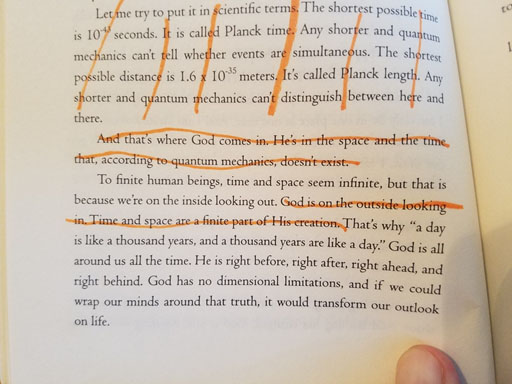
Batterson writes about the Planck Limit on time and space. His physics is not quite precise, but he continues on page 33 to say, “Maybe it’s time to stop placing four-dimensional limits on God.” This is what I absolutely believe. God created out four-dimensional world consisting of three space dimensions and one time dimension. But he exists outside of it and therefore can do “miracles”. To be clear, none of this conjecture is supported by scripture. There is some support/speculation in physics though. In 1919, Theodor Kaluza sent Albert Einstein a reformulation of General Relativity into a five-dimensional framework, Kaluza-Klein Theory. And lately, string theory has attempted to formulate a Theory of Everything (TOE) that uses 10 or 11 dimensions. I believe that God exists in those extra dimensions also and that is where the spiritual world exists; heaven, angels, demons, the Satan, four-wheeled living creatures observed by Ezekiel and more. Ezekiel 1:20–21 “Wherever the spirit wanted to go, they went, and the wheels rose along with them, for the spirit of the living creatures was in the wheels. When those went, these went; and when those stood, these stood; and when those rose from the earth, the wheels rose along with them, for the spirit of the living creatures was in the wheels.” (ESV)

Scripture hints at these “higher thoughts” in
Isaiah 55:8-10
“For my thoughts are not your thoughts,
neither are your ways my ways,”
declares the Lord.
“As the heavens are higher than the earth,
so are my ways higher than your ways
and my thoughts than your thoughts.
VIII. On page 37 he talks about that we tend to rank miracles. That is true. Then he says, “To the infinite all finites are equal.” I think I follow that?
IX. On page 38 he discusses prayer walk based on the story of Jericho and how the walls came tumbling down. His tiny congregation did prayer walks around the property of what was to become NCC starting 20 years earlier.
X. On page 40 he says, “Nothing you do right will go unrewarded.” I might take some theological exception to this. It’s getting too close to the ‘works versus faith’ argument. But it is true that God keeps a record of your actions?
Rev 20:12 “And I saw the dead, small and great, stand before God; and the books were opened: and another book was opened, which is the book of life: and the dead were judged out of those things which were written in the books, according to their works.”
2 Cor 5:10 “For we must all appear before the judgment seat of Christ; that every one may receive the things done in his body, according to that he hath done, whether it be good or bad.”
But also:
Heb 8:12”For I will be merciful to their unrighteousness, and their sins and their iniquities will I remember no more.”
Heb 10:17 “And their sins and iniquities will I remember no more.”
XI. On page 49 Batterson makes, to me, a key point in this book; “We are literally upgrading our minds by downloading the mind of Christ.” That is, we are literally changing our thinking structures when we continually read Scripture. Page 50; “The way to upgrade our mind is to download Scripture.”
XII. Excellent advice about prayer starting on page 68; “Many of our prayers are misguided. We pray for comfort instead of character. We pray for an easy way out instead of the strength to make it through.” Page 69; “So why do we assume that what we pray for is always what’s best for us? If we could see what God sees, we would pray very different prayers.” Page 69 again; “Maybe prayer is less about changing our circumstances than it is changing our perspective.” Page 70; “When I get into a spiritual or emotional slump, it’s usually because I’ve zoomed in on a problem.”… “…the solution is zooming out…”. Page 71; “So how do we zoom out? The one-word answer is prayer.” “Don’t let what’s wrong with you keep you from worshipping what’s right with God.” “…one of the purest forms of worship is praising God even when you don’t feel like it, because it proves that your worship isn’t circumstantial.” Page 72; “The most important choice you make every day is your attitude.”
XIII. Page 86; “But what if instead of spending all our energy making plans for God, we spent energy seeking God?”
XIV. On page 88 he mentions Werner Heisenberg and the Uncertainty Principle; a cornerstone of quantum mechanics. The uncertainty principle uses the Planck Limit above. “In quantum mechanics, the uncertainty principle (also known as Heisenberg’s uncertainty principle) is any of a variety of mathematical inequalities asserting a fundamental limit to the accuracy with which the values for certain pairs of physical quantities of a particle, such as position, x, and momentum, p, can be predicted from initial conditions.”
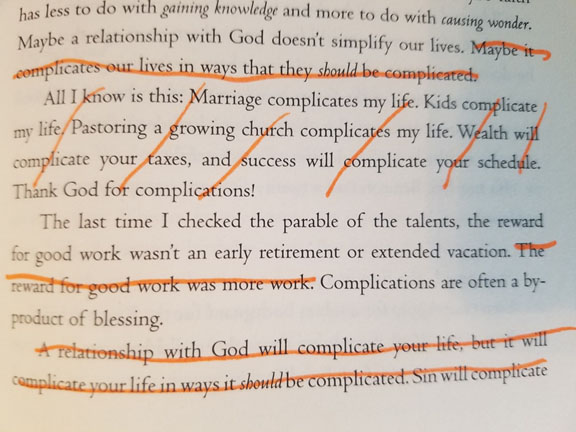
XV. Building off the Uncertainty Principle, Batterson goes on (page 107) to discuss ‘the butterfy effect’ where tiny changes in initial condition produce vast changes in the final condition.
XVI. On page 120 he states, “We usually regret our actions over the short term. But over the long haul, we tend to regret inactions.” This is a very true statement.
XVII. I’m not sure I believe this on page 152: “…that most people’s number one fear is speaking in public. Death ranks number two.”
XVIII. This is a little mentioned fact that is true, page 154; “Have you read the Bible recently? Lots of wild and wacky stuff! At face value, God says and does lots of things that seem awfully weird.” See especially the crazy prophesies of Daniel, Ezekiel and John in Revelation.
XIX. “Neotony: the retention of youthful qualities by adults.”, page 158. He goes on to quote, Matthew 18:3 “Truly, I say to you, unless you turn and become like children, you will never enter the kingdom of heaven.” (ESV) or Luke 18:17 “Truly, I say to you, whoever does not receive the kingdom of God like a child shall not enter it.” (ESV)… On page 160; “But we allow the Enemy to steal, kill, and destroy those childlike dreams.”
XX. On page 162, Batterson quotes ‘Ron Rolheiser’:
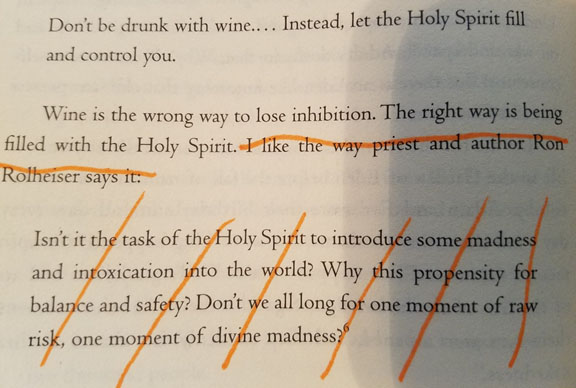
XXI. It’s good to read that Batterson reads Rolheiser. In last month’s Floating Book Review we looked at Ron Rolheiser’s book “The Holy Longing”. We loved it.
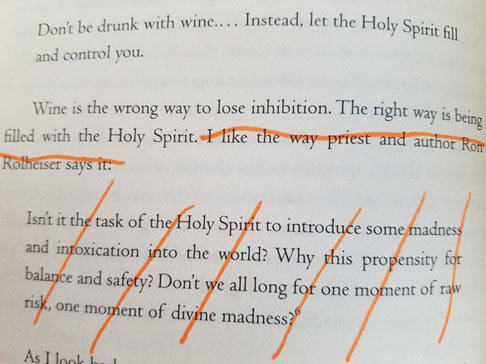
XXII. “Let me make an observation.”, page 163
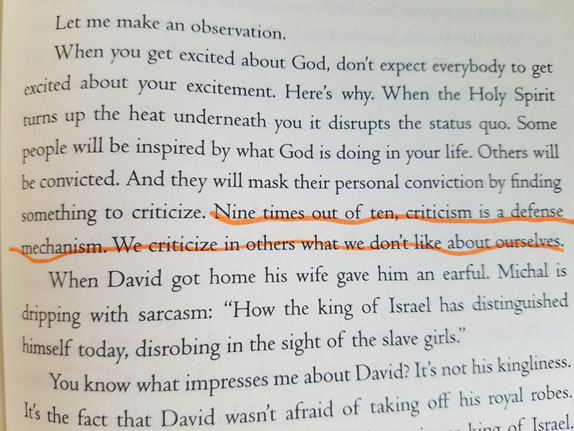
XXIII. He goes on to make the key point on page 164, “Part of spiritual maturity is caring less and less about what people think about you and more and more about what God thinks about.” … “The holiest and healthiest people in the world are those who laugh at themselves the most.”
XXIV. Page 181; “Aging is the process of accumulating evidence of God’s faithfulness and the cumulative evidence is overwhelming.”
XXV. Page 182; “I don’t believe in the prosperity gospel, but I don’t believe in the poverty gospel.”
I appreciate that Batterson makes this statement. There is a belief that God, and Jesus, “prefer” the poor. I commented on this in my review of Ron Rolheiser’s book “The Holy Longing” where he comments on the Roman Catholic teaching of the preferential option for the poor. I think that this is misguided. God cares for the (materially) poor just as much as the rich. Being “poor” does not make one more spiritual or deserving of God’s grace. Notions like this tend to distort the message of the cross that is meant for everyone.
All in all, this is an excellent book that makes some key points: ‘we are literally changing our thinking structures when we continually read Scripture’ (page 49) and ‘on what we should pray for’ (pages 69-86).
To end on a humorous note, Pastor Batterson is listed as number 8 in this list of ‘false teachers’. Apparently this is based on his follow-up, bestselling book from 2016, “The Circle Maker: Praying Circles Around Your Biggest Dreams and Greatest Fears”. They claim, “Based on an old Jewish Legend from the Talmud, Batterson teaches his readers to draw a circle on the ground, step inside the circle, and pray, and that by doing so, you will be able to access untold blessings from God. In his book, he also twists the Scriptures to teach a form of the prosperity gospel, he writes,” They might be accusing him of believing in sea bears:
2. “Drunk” by Edward Slingerland (369 pages hardcover, published 2021). Subtitled “How We Sipped, Danced, and Stumbled Our Way to Civilization”. Slingerland hypothesizes why ‘intoxication’ has continued in human societies even though the obvious negative effects of drugs and especially alcohol are well known. And be sure to see the excellent advice from my grandson James at the end of the video:
I. Edward Slingerland is a professor at the University of British Columbia. The book is entertaining, and he also backs his assertions and thesis with published studies.
II. The objective of the book is to explain why virtually every human society uses some form of intoxicants, especially alcohol, ever though the effect on individuals, families and society is obviously negative (page 10, ‘…convincing answer to the basic question of why we want to get high in the first place.’). On page 11 he states his thesis; ‘My central argument is that getting drunk, high or otherwise cognitively altered must have, over evolutionary time, helped individuals to survive and flourish, and culture to endure and expand.’ He goes on to say; ‘There are very good evolutionary reasons why we get drunk. What this means is that most of what we think we know about intoxication is wrong, incoherent, incomplete, or all of the above.’
III. On page 12, he claims; ‘We could not have civilization without intoxication.’ After finishing his book, I agree with this.
IV. On pages 13-14; he explains why alcohol is ‘the perfect intoxicant’. Sorry, Huey; you’re wrong “Huey Lewis And The News – I Want A New Drug”. Although I do agree that a hangover free alcohol would be the best invention since sliced bread. See also page 98 on this subject.
V. He does warn against two ‘recent’ innovations in the use of alcohol: page 14-15: ‘The relative recent innovations of distillation and social isolation entirely change intoxicants’ balance…’ And I agree with his general argument here also.
VI. On page 35, he makes the interesting comment, ‘I was trained as a historian of religion…’ He uses that as a jumping off point on how much of religion is irrational/illogical/random. So it is with alcohol use but no one questions it with regards to religion.
VII. He goes on to discuss the two current theories of why we still use alcohol even given it deleterious effects: hangover [from the past] and hijacking. He then spends quite a bit of the book offering evidence against these two theories.
VIII. On page 64-65 he makes the insightful comment, ‘Humans are powerful in groups precisely because we are weak as individuals…’
IX. On page 70 he makes another insightful comment about how hard and long (~20 years) it takes to raise human babies, ‘…these little ones are such an enormous hassle to deal with that they need grandmothers [having gone through menopause] to survive.’
X. An example of the studies he quotes is on page 70 on ‘blickets’.
XI. Is alcohol a CNS depressant? Central Nervous System. Yes, but more. Alcohol is biphasal. “Most people know that a few drinks make them feel good. So, they assume that a lot of drinks will make them feel even better. But that’s not true. Although a few drinks will make them feel better, more will make them feel worse. It’s the biphasic effect or the biphasic effects.”
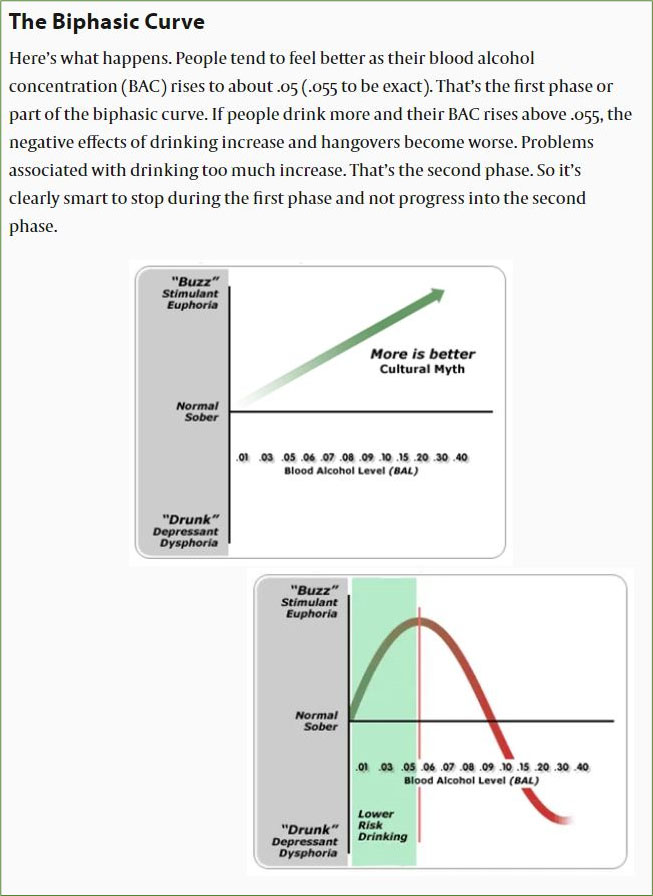
XII. As an aside, being a religious historian, he does quote scripture. An example on page 117, Proverbs 31:6 “Give strong drink to the one who is perishing, and wine to those in bitter distress;…”. Note that I used the ESV translation instead of his translation.
XIII. “Remember Windows ME?” And I like that he is a fan of the xkcd comic on page 164. I used xkcd in my last Opportunity Cost post.

XIV. On page 166 he discussed the concept of considering every important decision first sober, then intoxicated, or vice versa; ‘… in ancient Persia no important decision was made without being discussed over alcohol, although it would not actually be implemented until reviewed sober the next day. Conversely, no sober decision would be put into practice until it could be considered, by the group, while drunk.’ My first boss at TRW in 1979 said that was how he would do employee raise reviews. He would write them and then rewrite them after two scotches. Sounds like a good idea to me.
XV. On page 169, he talks about “…a strong case can be made that alcohol facilitated sociality plays a similarly pivotal role in academic innovation [and business]”. In the footnote (below) he claims that The Oasis (The “O”, now closed) played a key role in the development of the computer industry. Having spent a fair amount of time at The O in the mid-1970s, I can’t say I saw any of that type of activity.
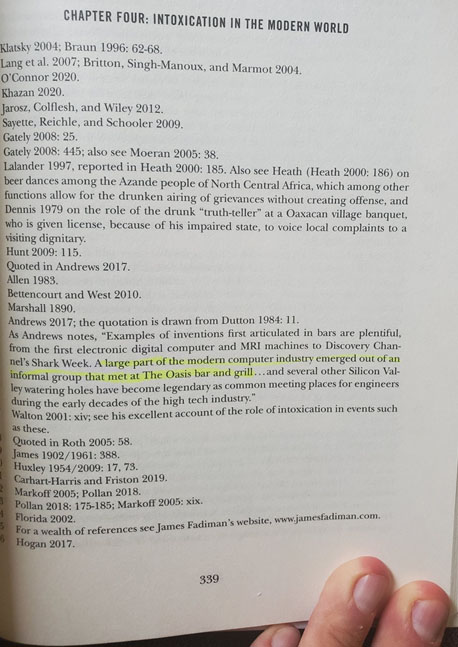
XVI. There is a good discussion of psychedelic drugs starting on page 173: “Psychedelic are powerful depatterning or entropy inducing agents, seriously disrupting the normally orderly flow of neural traffic directed by the PFC.” This includes microdosing of LSD in Silicon Valley. There’s more on page 208 where he reports that psilocybin users considered it “…the single most significant experience of their lives or…” Also, psychedelics are now being used to treat various addictions.
XVII. On page 179, Slingerland laments that Canadian regulation prevent grant money being used for the purchase of alcohol, “…American and Canadian federal regulations forbid spending grant funds on alcohol. In my view, this presents a serious barrier to scientific progress.” Slingerland needs to microdose his accountants with LSD. Then they could figure out a way around this; like most of the US defense industry. Money is fungible.
XVIII. He mentions the “Office Christmas Party” movie as an (fictional) example of the benefits of alcohol and drugs both in team building and scientific innovation (internet through the power lines). I watched the movie and will give a mini review. First half was great; second half didn’t finish strong. Entertaining. And the ‘internet through the power lines’ idea: “…a number of fundamental challenges, the primary one being that power lines are inherently a very noisy environment.”
XIX. Page 195 has a funny discussion of people’s faces after 0, 1, 2, and 3 drinks. Exactly what you would expect:

XX. Chapter 5 discusses “The Dark Side of Dionysus”. He discusses the heritability of alcoholism and it’s differing effects in different culture comparing family drinking in Italy to solitary vodka swilling in Russia. On page 236 he states, “It is very difficult to pass out from drinking beer or wine; it is nearly impossible to kill oneself. Once distilled liquors are in the mix, all bets are off.”. I would dispute the first phrase (“pass out from drinking beer or wine”) but am intrigued by the second. Are deadly alcohol fatalities (not accidents) all related to liquor?
XXI. On page 283 he starts his Conclusion with the story of Jesus turning water into wine as his first public miracle. This is to show (for Slingerland, not Jesus) the centrality of alcohol in human culture.
XXII. All in all, a great book. It is entertaining and educational.
3. “Dominus” by Steven Saylor (496 pages hardcover, published 2021): I found this book doing research about the rise of Christianity during my review of Pastor Jeff’s recommendation, “The Rise of Christianity”. Saylor writes historical fiction. I have read and greatly enjoyed his “Sub Rosa” series of books about a ‘detective’ in Ancient Rome during the transition from Republic to Empire. Again, here he fictionalizes history while remaining true to the known, historical sources. He recounts the history of Rome (mostly the emperors) from Marcus Aurelius in about 160 AD culminating about 300 AD with Constantine and his “making” Christianity the state religion. The plot device here is highlighting a fictional, old Roman family (that go back to the founding of Rome) and their interactions with the various emperors. The Pinari family are artists, sculpture, builders and so forth. They are also members of the Roman Senate. So, there is a rationale for them having access to the various emperors.
I. Saylor fictionalizes real history by inserting characters who participate in the actions of real characters (e.g., Marcus Aurelius, Constantine the Great) and provide side comments and motivations for various actions that are not clearly described by history (e.g., why did Constantine have his oldest son and wife killed a few days apart).
II. This is the end of a three-part series (Roma, Empire, Dominus) from the days of Caesar to Constantine’s reign in the early 300s AD.
III. Constantine sort of makes Christianity the state religion of the Roman Empire. He “forces” the Christian leaders to agree on their key beliefs at the “First Council of Nicaea”: “Constantine’s role regarding Nicaea was that of supreme civil leader and authority in the empire.”
IV. Constantine also start building Constantinople (now Istanbul), drafting the Pinari to accompany him and hopefully leading to more books.
V. I really like this plot device of putting fictional characters in history. It makes the history interesting; especially for the parts where the historical record is thin or non-existent. His account of the killings above and the discussion of “the Rain Miracle” are particularly well done. Note that in the back of the book, Saylor discusses his sources and points out where he “invented” material. It would be worth reading these few pages before you read the novel.
VI. Saylor is openly gay, and the book does have a homoerotic subcurrent. But that is in keeping with the explicitly erotic history of Rome and most ancient cultures.
VII. Dominus means “Master” as a slave would address his master. Eventually this form of address refers to anyone well above you in the social ranks.
VIII. Saylor does an excellent job or weaving the rise of Christianity into the story without making it obvious. The Pinari have their own ‘good luck charm’ a ‘fascinum’ that goes back to the days of the founding of Rome by Romulus and Remus (that would have been a good name for a kid’s cartoon show). The fascinum is a winged penis.
IX. Finally, I particularly enjoyed his weaving the famous physician Galen through the early part of the book.
X. I may have read “Roma” and “Empire”, but I might go back and read them (again). His writing is a pleasant diversion into another world.
4. “The Patriot’s Fate” by Alaric Bond (318 pages softcover, published 2012). I read and reviewed the first four books in this British Naval Fiction, “His Majesty’s Ship”, “The Jackass Frigate” True Colors”, and “Cut and Run”. I give them high marks. Now that I read the first four installment in the series, I like it even more.
I. There will be spoilers in my comments so beware…
II. This is the fifth book in Alaric Bond’s series “The Fighting Sail”.
III. Unlike most books in these series (O’Brian, Forrester, Kent, Lambdin, Pope…) the plot does not follow the rise of a captain from either humble (Forrester) or noble (Kent?) beginnings. Bond follows a number of characters present in a British warship of the Napoleonic Era; from the captain on down to the lowest sailor and the various hangers on in any ship; male and female. “these have no central hero but feature characters from all ranks and stations; an innovative approach that gives an exciting and realistic impression of life aboard a warship of the period.” That way there is some tension on who might get killed at any time. For example, in the first book, the captain was killed at the very beginning of the big battle.
IV. Each book has a ‘big battle’, almost always based on a real battle where he introduces fictional characters that take part in real history (as with Saylor in the Dominus book above). Bond is excellent with his battle scenes; the best of the lot I’ve read. Here is a good review of his historical accuracy “I have bypassed Mr. Bond’s stories for a long time. Years really. I finally decided to give one a try and was delighted, entertained, and impressed by the color, technical detail, character development, story line, action and unexpected twists and turns. I love historical nautical fiction, particularly of the French Revolution and Napoleonic era. This is an enjoyable read that starts out slow with a lot of characters being introduced early … The last half of the book built tension, introduced even greater conflict among shipmates who each had an agenda, attitudes and a distinct life. Also the action intensified with each page and as it intensified the true inner character of each person was intelligently revealed. This book has one of the best fictitious sea battles I’ve ever had the pleasure of reading. …This is truly good entertainment at a very good price.”.
.
V. [SPOILER]. There does seem to be one key character emerging, Lt King. He is in all five books and is ‘growing’. He is of modest background and so forth. In an earlier book, he befriends an Irishman who is a seaman so is not of his social class. They become “friends”. In this book they are separated and it comes to the worst end. King unknowingly kills his friend in the midst of the climatic battle. This is depicted on the cover:
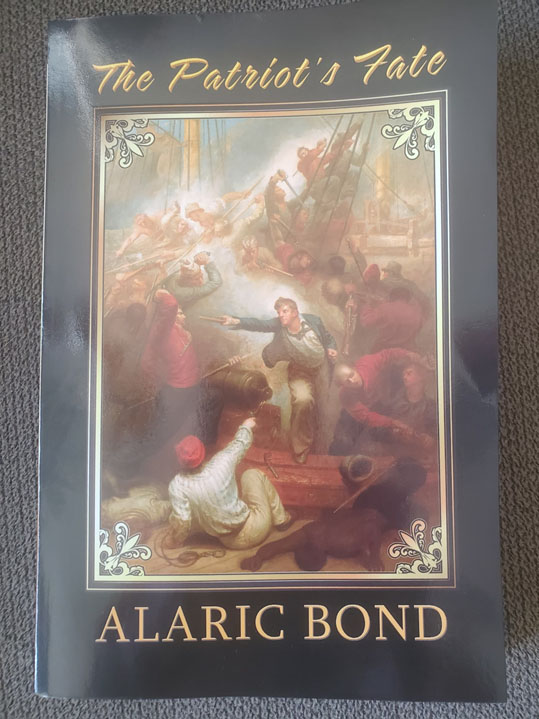
VI. The book is a fictionalization of the French attempt to ferment an Irish rebellion against their British overlords in 1803. It includes the real Irish revolutionary Wolfe Tone. His interactions with the fictional, doomed friend are very well done. Tone’s complete story is fascinating although this is not in the book.
VII. All in all, this is becoming my favorite of these series of books. You can read more about Alaric Bond at https://www.alaricbond.com/.
That’s all for the month of July. We will see you next month for more TMP Floating Book Reviews.
